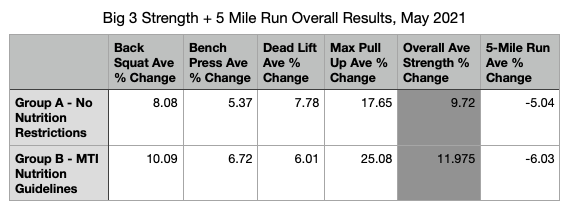By Rob Shaul, Founder
BLUF
Remote lab rats who followed MTI’s nutritional guidelines slightly outperformed those who didn’t in strength and endurance gains resulting from MTI’s Big 3 Strength + 5 Mile Run programming. However, both groups saw concurrent improvements in total body strength and 5-mile run performance.
Background and Study Design
We conducted a 3.5-week Mini-Study using remote lab rats to test:
- The effectiveness of MTI’s Big 3 Strength + 5 Mile Run programming to concurrently improve total body strength and endurance
- The effect, if any, of MTI’s Nutritional Guidelines on fitness improvement.
Twenty-three remote lab rats completed this 3.5 week mini study, 15x in Group A (no nutrition restrictions) and 8x in Group B (MTI Nutrition Guidelines).
Each group followed the same, 3.5 week, 6 day/week progressive Big 3 Strength + 5 Mile Run programming.
Max effort assessments were completed at the beginning and end of the cycle for these exercises:
(1) 1 Repetition Maximum (1RM) Back Squat
(2) 1RM Bench Press
(3) 1RM Dead Lift
(4) Max Rep Pull Ups
As well, the lab rats completed a 5-mile run for time at the beginning and end of the cycle.
After the initial assessments, the lab rats all completed the following training schedule for 3 Weeks
- Monday: Density Strength Progression for the Back Squat, Bench Press, Dead Lift and Pull Ups
- Tuesday: Threshold 2 mile intervals with the pace based on the individual athlete’s initial 5-mile run assessment finish time
- Wednesday: Density Strength Progression for the Back Squat, Bench Press, Dead Lift and Pull Ups
- Thursday: Threshold 2 mile intervals with the pace based on the individual athlete’s initial 5-mile run assessment finish time
- Friday: Density Strength Progression for the Back Squat, Bench Press, Dead Lift and Pull Ups
- Saturday: Moderate-Pace, 6-8 mile distance run
- Sunday: Rest
The lab rats were not allowed to complete any other fitness training during the 3-week study period. They were allowed to complete active recreation on the weekends.
At the end of the 3 weeks, the lab rats re-completed the strength assessments and 5-mile Run assessments. The results from the pre and post cycle assessment were then compared.
Results and Discussion
A total of 23 individuals completed the entire training 3.5 week cycle. Below are the individual lab rat results.
One note concerning the above results for Group B – the MTI Nutrition Group: Two of the athletes were females (Danyelle and Morgan) who doubled or more their pull ups. However, each athlete’s second max rep assessment was still 5 or less pull-ups. Their increases of 100% and 150% in pull up max reps artificially skewed Group B’s strength improvement results. When their pull up scores are taken out of the data set, Group B’s average % pull up improvement was 25.08%.
Below is the overall strength and run improvement for both groups:
Both groups saw strength and endurance improvements following this program – with Group A seeing an overall strength average improvement of 9.72% and Group B, 11.98%.
Both Groups also improved times on the 5-mile run assessments.
Overall, Group B, the MTI Nutrition Guidelines Group slightly outperformed Group A in strength and endurance improvement.
However, Group B’s slight outperformance isn’t significant for us to determine that MTI’s nutritional guidelines made a significant difference.
Somewhat surprisingly, the average Group A lab rat – with no nutrition restrictions – lost more weight (5 pounds) than the average Group B athlete (2.75 pounds) – despite the significant carb reduction in MTI’s nutritional guidelines.
We’re honestly not sure what to make of this result. We were expecting a much more significant weight loss from the Group B athletes.
Anecdotally, despite these overall strength and endurance improvements, many of the lab rats reported struggling with the intensity of the programming, especially the 2-mile threshold running intervals on Tuesdays and Thursdays. Most struggled to make their individually scaled pacing for these efforts.
For a few, this intense programming was their first introduction to MTI programming, but even some of the lab rats who have completed multiple MTI programs in the past reported struggling with the program’s intensity and overall recovery from the training.
Next Steps?
We were pleased to see the overall dual gains in strength and endurance from this mini-study, which helps validate the focus of MTI’s progressions.
However, we may need to re-visit the pacing for the 2-mile intervals, and perhaps cut one day of programming from the cycle to increase recovery time.
Questions? Email rob@mtntactical.com
Comments? Please comment below.



